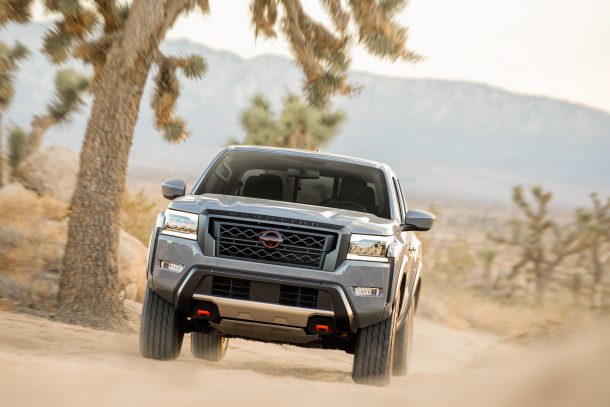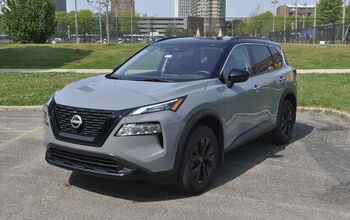QOTD: Should Design Be Consistent Across Brands?

Let me start this out with an auto-writer pet peeve of mine: I hate the phrase “design language.” I have since I started working in automotive media in 2007. I am not sure why — it’s probably just too much PR/corporate speak for me.
I’ve banned that phrase from this site via our internal style guide (although I am sure it slips through sometimes. Please don’t play “gotcha” and @ me with examples), and constantly avoided using it for over 13 years, even if that’s lead to some awkward phrasing in its stead.
Thing is, there’s a reason why just about every OEM uses it.
That’s because they want to convey a brand identity — they want all their cars and trucks, across all class sizes and market segments, to be instantly recognizable as belonging to that brand. That’s true even with vehicles that have standout looks or have a historical trend to follow (Mustang, Wrangler, Corvette, et cetera). Even distinctive cars get some feature — badging, grille shape, lighting design — that reminds you what brand the car is.
In other words, the Mustang has always stood out from other Fords, or the Corvette from other Chevrolets, but there’s usually something that ties the car to the brand. Even if the admittedly unlikely event you didn’t already know Ford sold the Mustang or Chevy the ‘Vette, you’d probably figure it out.
That’s often been the way of the automotive world. OEMs share common styling elements — grilles, lighting, wheels, even the general shape — across lineups so that consumers make the connection between model and make.
This works best with vehicles that aren’t iconic like the Corvette. Non-car people might not know what a Fusion is, but they might know it’s a Ford via the grille, even if the Blue-Oval badge was missing.
Enter the next Nissan Frontier. Unveiled Thursday, its grille reminds me of its big sibling, the Titan. And that doesn’t shock me in the least.
The question is, is it better for brands to strive for consistency across the board, or should brands work to differentiate models of different size/segment/type more than they do?
Obviously, costs/regulation play a factor here, too. But let’s pretend that they didn’t for a second. Just from a purely philosophical point of view — is it better for a brand to have consistency across the line? So that the outside observer who doesn’t know a spark plug from a piston can tell that they’re seeing a Nissan drive by? Or would brands best be served by allowing creativity to flow from segment to segment and model to model?
Answer below, folks.
[Image: Nissan]

Tim Healey grew up around the auto-parts business and has always had a love for cars — his parents joke his first word was “‘Vette”. Despite this, he wanted to pursue a career in sports writing but he ended up falling semi-accidentally into the automotive-journalism industry, first at Consumer Guide Automotive and later at Web2Carz.com. He also worked as an industry analyst at Mintel Group and freelanced for About.com, CarFax, Vehix.com, High Gear Media, Torque News, FutureCar.com, Cars.com, among others, and of course Vertical Scope sites such as AutoGuide.com, Off-Road.com, and HybridCars.com. He’s an urbanite and as such, doesn’t need a daily driver, but if he had one, it would be compact, sporty, and have a manual transmission.
More by Tim Healey
Latest Car Reviews
Read moreLatest Product Reviews
Read moreRecent Comments
- Ajla A union fight? How retro 😎
- Analoggrotto Finally, some real entertainment: the Communists versus the MAGAs. FIGHT!
- Kjhkjlhkjhkljh kljhjkhjklhkjh *IF* i was buying a kia.. (better than a dodge from personal experience) .. it would be this Google > xoavzFHyIQYShould lead to a 2025 Ioniq 5 N pre-REVIEW by Jason Cammisa
- Analoggrotto Does anyone seriously listen to this?
- Thomas Same here....but keep in mind that EVs are already much more efficient than ICE vehicles. They need to catch up in all the other areas you mentioned.


































Comments
Join the conversation
The "What NOT to do" example on this is 1990s Infiniti. The Q45, J30, I30, QX4 and G20 may as well have all come from different manufacturers. Genesis seems to have escaped a similar trap of "THIS shall be our grille look for this new brand.... oh wait, we meant THIS instead." by doing just one switch.
As others have said, from the side and rear, most CUVs/SUVs look very similar, so brands are going out of their way to have a brand-style grille/light treatment. I guess there is only so much that can be done with maintaining a tall boxy 2 box shape. Though I'd say the same about cars from a century ago, before the 30s/aero era I find them difficult to tell apart (and indeed later in the century, 50s Americana sedans were all similar with fins and chrome) In Europe, arguably Ford's most street-cred era was the 70s when they didn't even use their logo on their cars, and the likes of the mk1 Escort, Capri and (euro) Granada were distinct. BMW sedans were traditionally small-medium-large of a similar style. Even Skoda about 8 years ago had a similar range with Rapid-Octavia-Superb being similar in different sizes. It seems increasingly important for brands, not just cars. You can tell a phone or a computer is an Apple product, you can tell a vacuum is a Dyson by the design language.